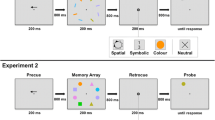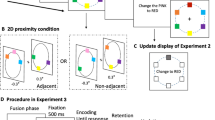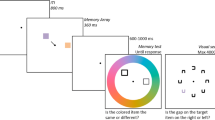Abstract
In the present study, we investigated how feature- and location-based selection influences visual working memory (VWM) encoding and maintenance. In Experiment 1, cue type (color, location) and cue timing (precue, retro-cue) were manipulated in a change detection task. The stimuli were color–location conjunction objects, and binding memory was tested. We found a significantly greater effect for color precues than for either color retro-cues or location precues, but no difference between location pre- and retro-cues, consistent with previous studies (e.g., Griffin & Nobre in Journal of Cognitive Neuroscience, 15, 1176–1194, 2003). We also found no difference between location and color retro-cues. Experiment 2 replicated the color precue advantage with more complex color–shape–location conjunction objects. Only one retro-cue effect was different from that in Experiment 1: Color retro-cues were significantly less effective than location retro-cues in Experiment 2, which may relate to a structural property of multidimensional VWM representations. In Experiment 3, a visual search task was used, and the result of a greater location than color precue effect suggests that the color precue advantage in a memory task is related to the modulation of VWM encoding rather than of sensation and perception. Experiment 4, using a task that required only memory for individual features but not for feature bindings, further confirmed that the color precue advantage is specific to binding memory. Together, these findings reveal new aspects of the interaction between attention and VWM and provide potentially important implications for the structural properties of VWM representations.








Similar content being viewed by others
References
Averbach, E., & Coriell, A. S. (1961). Short-term memory in vision. Bell System Technical Journal, 40, 309–328.
Baddeley, A. D., & Hitch, G. J. (1974). Working memory. In G. H. Bower (Ed.), The psychology of learning and motivation: Advances in research and theory (Vol. 8, pp. 47–89). New York: Academic Press.
Becker, M. W., Pashler, H., & Anstis, S. M. (2000). The role of iconic memory in change-detection tasks. Perception, 29, 273–286. doi:10.1068/p3035
Berryhill, M. E., Richmond, L. L., Shay, C. S., & Olson, I. R. (2011). Shifting attention among working memory representations: Testing cue type, awareness, and strategic control. Quarterly Journal of Experimental Psychology, 65, 426–438. doi:10.1080/17470218.2011.604786
Brainard, D. H. (1997). The Psychophysics Toolbox. Spatial Vision, 10, 433–436. doi:10.1163/156856897X00357
Chun, M. M., Golomb, J. D., & Turk-Browne, N. B. (2011). A taxonomy of external and internal attention. Annual Review of Psychology, 62, 73–101. doi:10.1146/annurev.psych.093008.100427
Fougnie, D., & Alvarez, G. A. (2011). Object features fail independently in visual working memory: Evidence for a probabilistic feature-store model. Journal of Vision, 11(12), 3:1–12. doi:10.1167/11.12.3
Green, D. M., & Swets, J. A. (1966). Signal detection theory and psychophysics. Huntington, NY: Robert E. Krieger Publishing Company
Griffin, I. C., & Nobre, A. C. (2003). Orienting attention to locations in internal representations. Journal of Cognitive Neuroscience, 15, 1176–1194. doi:10.1162/089892903322598139
Katus, T., Andersen, S. K., & Müller, M. M. (2014). Common mechanisms of spatial attention in memory and perception: A tactile dual-task study. Cerebral Cortex, 24, 707–718. doi:10.1093/cercor/bhs350
Kondo, A., & Saiki, J. (2012). Feature-specific encoding flexibility in visual working memory. PLoS ONE, 7(e50962), 1–8. doi:10.1371/journal.pone.0050962
Kuo, B.-C., Rao, A., Lepsien, J., & Nobre, A. C. (2009). Searching for targets within the spatial layout of visual short-term memory. Journal of Neuroscience, 29, 8032–8038. doi:10.1523/JNEUROSCI.0952-09.2009
Landman, R., Spekreijse, H., & Lamme, V. A. F. (2003). Large capacity storage of integrated objects before change blindness. Vision Research, 43, 149–164. doi:10.1016/S0042-6989(02)00402-9
Ling, S., Liu, T., & Carrasco, M. (2009). How spatial and feature-based attention affect the gain and tuning of population responses. Vision Research, 49, 1194–1204.
Luck, S. J., & Vogel, E. K. (1997). The capacity of visual working memory for features and conjunctions. Nature, 390, 279–281. doi:10.1038/36846
Makovski, T., Sussman, R., & Jiang, Y. V. (2008). Orienting attention in visual working memory reduces interference from memory probes. Journal of Experimental Psychology: Learning, Memory, and Cognition, 34, 369–380. doi:10.1037/0278-7393.34.2.369
Matsukura, M., Luck, S. J., & Vecera, S. P. (2007). Attention effects during visual short-term memory maintenance: Protection or prioritization? Perception & Psychophysics, 69, 1422–1434. doi:10.3758/BF03192957
Munneke, J., Heslenfeld, D. J., & Theeuwes, J. (2010). Spatial working memory effects in early visual cortex. Brain and Cognition, 72, 368–377. doi:10.1016/j.bandc.2009.11.001
Nobre, A. C., Coull, J. T., Maquet, P., Frith, C. D., Vandenberghe, R., & Mesulam, M. M. (2004). Orienting attention to locations in perceptual versus mental representations. Journal of Cognitive Neuroscience, 16, 363–373.
Pelli, D. G. (1997). The VideoToolbox software for visual psychophysics: Transforming numbers into movies. Spatial Vision, 10, 437–442. doi:10.1163/156856897X00366
Phillips, W. A. (1974). On the distinction between sensory storage and short-term visual memory. Perception & Psychophysics, 16, 283–290. doi:10.3758/BF03203943
Posner, M. I., Snyder, C. R., & Davidson, B. J. (1980). Attention and the detection of signals. Journal of Experimental Psychology: General, 109, 160–174. doi:10.1037/0096-3445.109.2.160
Rensink, R. A., O’Regan, J. K., & Clark, J. J. (1997). To see or not to see: The need for attention to perceive changes in scenes. Psychological Science, 8, 368–373. doi:10.1111/j.1467-9280.1997.tb00427.x
Schmidt, B. K., Vogel, E. K., Woodman, G. F., & Luck, S. J. (2002). Voluntary and automatic attentional control of visual working memory. Perception & Psychophysics, 64, 754–763. doi:10.3758/BF03194742
Scholl, B. J. (2000). Attenuated change blindness for exogenously attended items in a flicker paradigm. Visual Cognition, 7, 377–396.
Shuman, M., & Kanwisher, N. (2004). Numerical magnitude in the human parietal lobe: Tests of representational generality and domain specificity. Neuron, 44, 557–569.
Sperling, G. (1960). The information available in brief visual presentations. Psychological Monographs: General and Applied, 74, 1–29. 11, Whole No. 498.
Tanoue, R. T., & Berryhill, M. E. (2012). The mental wormhole: Internal attention shifts without regard for distance. Attention, Perception, & Psychophysics, 74, 1199–1215. doi:10.3758/s13414-012-0305-0
Theeuwes, J. (1989). Effects of location and form cuing on the allocation of attention in the visual field. Acta Psychologica, 72, 177–192. doi:10.1016/0001-6918(89)90043-7
Theeuwes, J., & Van der Burg, E. (2007). The role of spatial and nonspatial information in visual selection. Journal of Experimental Psychology: Human Perception and Performance, 33, 1335–1351. doi:10.1037/0096-1523.33.6.1335
Treisman, A. (1988). Features and objects: The Fourteenth Bartlett Memorial Lecture. Quarterly Journal of Experimental Psychology, 40A, 201–237. doi:10.1080/02724988843000104
Treisman, A. M., & Gelade, G. (1980). A feature-integration theory of attention. Cognitive Psychology, 12, 97–136. doi:10.1016/0010-0285(80)90005-5
Treue, S., & Martínez-Trujillo, J. C. (1999). Feature-based attention influences motion processing gain in macaque visual cortex. Nature, 399, 575–579. doi:10.1038/21176
Vogel, E. K., Woodman, G. F., & Luck, S. J. (2001). Storage of features, conjunctions, and objects in visual working memory. Journal of Experimental Psychology: Human Perception and Performance, 27, 92–114. doi:10.1037/0096-1523.27.1.92
Wheeler, M. E., & Treisman, A. M. (2002). Binding in short-term visual memory. Journal of Experimental Psychology: General, 131, 48–64. doi:10.1037/0096-3445.131.1.48
Woodman, G. F., Vecera, S. P., & Luck, S. J. (2003). Perceptual organization influences visual working memory. Psychonomic Bulletin & Review, 10, 80–87. doi:10.3758/BF03196470
Zhuang, X., & Papathomas, T. V. (2011). Cue relevance effects in conjunctive visual search: Cueing for location, color, and orientation. Journal of Vision, 11(7), 6:1–13. doi:10.1167/11.7.6
Author information
Authors and Affiliations
Corresponding author
Rights and permissions
About this article
Cite this article
Li, Q., Saiki, J. Different effects of color-based and location-based selection on visual working memory. Atten Percept Psychophys 77, 450–463 (2015). https://doi.org/10.3758/s13414-014-0775-3
Published:
Issue Date:
DOI: https://doi.org/10.3758/s13414-014-0775-3




